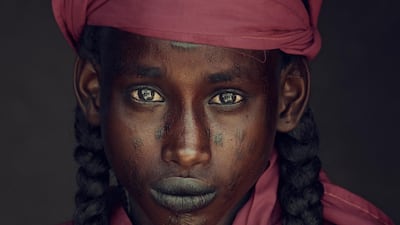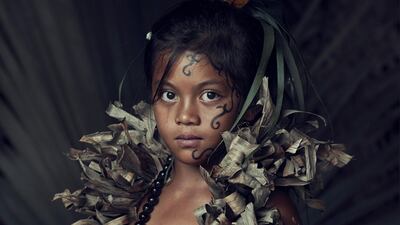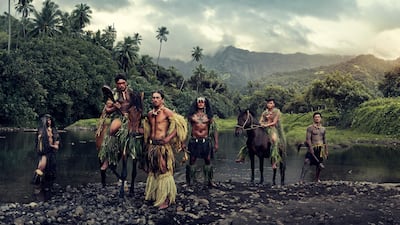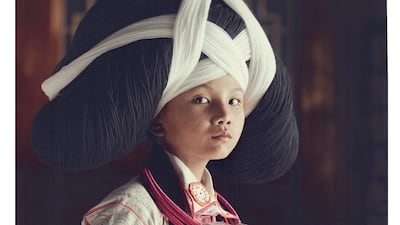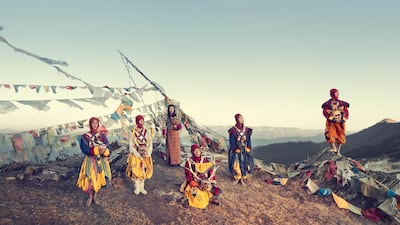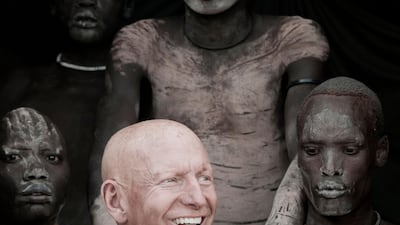The award-winning photographer Jimmy Nelson's latest series of images was shot in the Andes in Peru, 5,500 metres above sea level, where a group from the Qeros tribe were going round a mountain.
Nelson, a photographer known for his portraits of people from remote areas, travelled with the group for a month, capturing them as they ploughed through the snow in their open sandals, young and old walking eight hours a day. One in particular – red-cheeked, chubby-faced Irika, who was eight years old – became particularly dear to him, and a kind of symbol of resilience, Nelson recounted recently while in Abu Dhabi.
Nelson is the artist in residence at CultureSummit 2018, the four-day talks and performances event in Abu Dhabi that has brought world cultural leaders to Manarat Al Saadiyat in Abu Dhabi.
His work chronicles beauty and diversity among indigenous people: the intricately embroidered textiles and extraordinary headpieces of the Changjiao Miao ethnic group of South-west China, where women wrap linen, wool and the hair of their ancestors around cattle longhorns on special occasions; the rich red costumes of the Dutch who live on Marken, an island long disconnected from mainland Holland; or the exuberant floral headpieces and shaggy fleece coats of the nomadic Dropka people, who live in a disputed territory between India and Pakistan.
There is a sense of time slipping by – his 2013 book was called Before They Pass Away – as these cultures lose their traditions under the twin onslaught of modernisation and globalisation.
The British-born photographer underlines that the indigenous tribes' connection to nature and their remove from capitalist systems are worth holding on to.
“You can’t save them,” he says. “Because who am I to say that you’ve got to spend the rest of your life standing on a rock holding up a shield and a spear. All I am saying is, ‘you look amazing’. All I am saying is, ‘you have something of a body, and a pride, and a connection and a wisdom that we’ve lost, and we want, and we’re grappling for, and at the same time you can’t stay there. But whilst you move on into the future, take it with you, and perhaps you’ll feel more balanced.”
In 2016, he set up the Jimmy Nelson Foundation for this mission, sending young photographers and cinematographers to take images of tribespeople and to teach them to record themselves, with the intent of making an online library of various indigenous heritages.
It is these practices that are the real subject of Nelson's work: he captures the tribespeople in their best, ceremonial dress, often shot from below, with proud, challenging looks directed at the camera. Indeed rather than research or or the adoption of ethnographic practices, Nelson's work is almost uniquely focused on the look of indigenous cultures – an element that, for Nelson, has its origins in his own personal relationship to his artistic practice. He was brought up in rural South Africa – his father was a geologist – and at the age of seven was sent to a Jesuit school in England. It was a total shock: not simply the transition from a wild and carefree childhood to the strict rules of an English boarding school but also one particular event that happened at age sixteen. He developed alopecia and, within six hours, all his hair fell out.
"One morning, you go from a sixteen-year-old head of hair to looking like an alien," he recalls. This, he says, deepened the awareness of difference he had gained in the transition from Africa to white Britain. "From a very young age you are raised with a judgment of colour, and then you yourself end up being different – aesthetically – and then you empathise with the other."
Nelson rebelled, and travelled around Tibet for two years. “It was to reconnect,” he says. “I had to find validity in myself, and acknowledgement. And here I am 33 years later, essentially doing the same thing. People say how can you go on, how can you do it? It’s an obsession to be happy – it’s an obsession to be seen and to be accepted by the other.”
He now lives in Amsterdam with his wife and three children, continuing years of travelling to remote destinations: the plains of Africa, the Tibetan plateau, the islands of Polynesia.
Nelson's descriptions of his photography projects – "You just submit, and you cry if it's cold, and you get bitten when you get bitten" – has the air of an earlier age of British expedition-making, and indeed his work has been criticised for a romanticising, colonialist worldview, promulgating visions of indigenous people that omit the realities – the western dress, the poverty, the elements of modernisation – that are equally part of their experiences.
Asked about this, he defends his approach. "Everybody has an opinion, what is colonialism, what is not," he says. "I see these people as if I want to put them on the cover of Vanity Fair. Whether that's right or wrong – time will tell.
"They've all been photographed before with a long lens from out a helicopter or a jeep, crawling out of a tent with flies in their eyes," he says. "They've rarely been photographed with someone who sat on their ass for a week saying, 'come to me when you're ready'." He says he photographs his subject "from a low perspective, using the villagers holding reflectors, making them beautiful, making them iconic, making them powerful.
“I don’t see that as colonialistic. I see that as respectful. I see that as dignified.”
